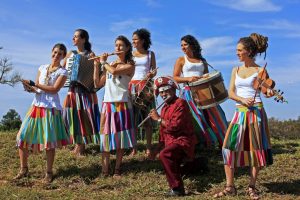By Rebecca Kleinmann
![]() The Pífano, pifaro or pife is a wind instrument of the Northeast region of Brazil. Usually made of bamboo or “taquara” wood, the pífano has seven holes: one for the embouchure, and six finger holes. Flutes of this basic design are some of the earliest known instruments and can be found in the cultures that blended in Brazil: African flutes, European military fifes, and flutes of Brazil natives are all precursors to the pífano. Historically, the pífano dates back to the era of the first Christian settlers in Brazil, who played fifes to honor the Virgin Mary in nativity celebrations. The Northeastern mestizos, with their musical creativity and intuition adapted the instrument into the folkloric music of Brazil.
The Pífano, pifaro or pife is a wind instrument of the Northeast region of Brazil. Usually made of bamboo or “taquara” wood, the pífano has seven holes: one for the embouchure, and six finger holes. Flutes of this basic design are some of the earliest known instruments and can be found in the cultures that blended in Brazil: African flutes, European military fifes, and flutes of Brazil natives are all precursors to the pífano. Historically, the pífano dates back to the era of the first Christian settlers in Brazil, who played fifes to honor the Virgin Mary in nativity celebrations. The Northeastern mestizos, with their musical creativity and intuition adapted the instrument into the folkloric music of Brazil.
Pífanos are often found in pairs, accompanied by percussion instruments including the zabumba, triangle, caixa, prato, bumbo and ganzá, forming “Bandas de Pífanos.” These bands originally formed in the Northeast of Brazil in the states of Paraíba, Ceará, Pernambuco, Alagoas, Piauí and Rio Grande do Norte, by rural workers of the semi-dry “Sertão” plataeu who would gather to play music for events in their communities. Music and knowledge of the instruments was passed down by ear to the sons and daughters of the rural workers, some who immigrated to cities in other parts of Brazil. They brought with them the pífano and also the Baião, the Sertão’s musical style that now is one of “Brazil’s most exportable styles.”
Baião, in brief, is characterized by the zabumba rhythm and tonality based on Lydian and Mixolydian scales. Baião gave way to many dance music styles, including Xaxado, Côco, Rasta Pé, and Forró. Forró is also the name of the popular couples dance parties of Northeast Brazil. One theory suggests that the term came from the English phrase “for all,” as English sailors often joined in dances in the coastal town of Recife.
 When Bandas de Pífanos play Baião and its derivative styles, the “Pífanos are the commanders.” They lead the band melodically with popular melodies such as Asa Branca, Mulher Rendeira and Sabiá, and harmonic lines, often improvised and played with a constant rhythmic drive. Many Banda de Pífanos have emerged from Brazil, the most famous being the “Banda de Pífanos de Caruaru” begun in 1924 and still in existence. Also celebrating 85 years is the “the Queen of Pífano” Zabé da Loca of Monteiro da Paraíba. In 2008 she released a record of her own compositions, recorded in Recife. One documentary shows Zabé da Loca looking to her instrument, saying “this is my life,” and actively passing on the tradition of pífano playing to young musicians.
When Bandas de Pífanos play Baião and its derivative styles, the “Pífanos are the commanders.” They lead the band melodically with popular melodies such as Asa Branca, Mulher Rendeira and Sabiá, and harmonic lines, often improvised and played with a constant rhythmic drive. Many Banda de Pífanos have emerged from Brazil, the most famous being the “Banda de Pífanos de Caruaru” begun in 1924 and still in existence. Also celebrating 85 years is the “the Queen of Pífano” Zabé da Loca of Monteiro da Paraíba. In 2008 she released a record of her own compositions, recorded in Recife. One documentary shows Zabé da Loca looking to her instrument, saying “this is my life,” and actively passing on the tradition of pífano playing to young musicians.
Other important “pifeiros” include Edmilson do Pífano, João de Pife, and Carlos Malta, who brought the pife into a new light in the public eye with his record “Pife Moderna.” In New York City, Brazilian flutist Jorge Continentino of the popular band Forro in the Dark, plays pífano chromatically, even playing bebop melodies on his pífano in G. Multiinstrumentalist Rodrigo Ursaia of Orquestra Jazz Sinfônica, talks about bringing the pífano into diverse projects including Rock and Jazz. He mentions a recent experience in which he played pífano on a Jazz recording and appreciated the warm, human-voice-like tone of the pífano with rich overtones.
A surge of Pífano playing in modern music has been assisted by instrument maker Jose Claudio de Oliveira Lino who designs pífanos in tune with modern instruments. Since the traditional instruments were once played with percussion only, there was no need to tune them to chordal instruments. The pifes come in different sizes, changing the pitch to play in different.
keys, and making it easier to play modern as well as traditional music. Today’s pífano players can be heard internationally as Forró gains new popularity in the major cities of the world including New York City and London. Flutist Dominique Gange of NYC that she likes playing music that makes people dance, describing the swing of Forro as “infectious and celebratory.” An increasing number of people worldwide are discovering the Northeastern Brazilian Folk dance and music. As they do, musicians are reaching for the traditional instruments of Brazil, including pífanos, to create Forró dance music and to creatively adapt them into their own music.
* Rebecca Kleinmann is an American musician from Santa Barbara, California and has traveled couple times to Brazil for studying and research. Her music has a strong influence of Brazilian music including chorinho and bossa nova. To know more about Rebecca visit www.rebeccakleinmann.com

